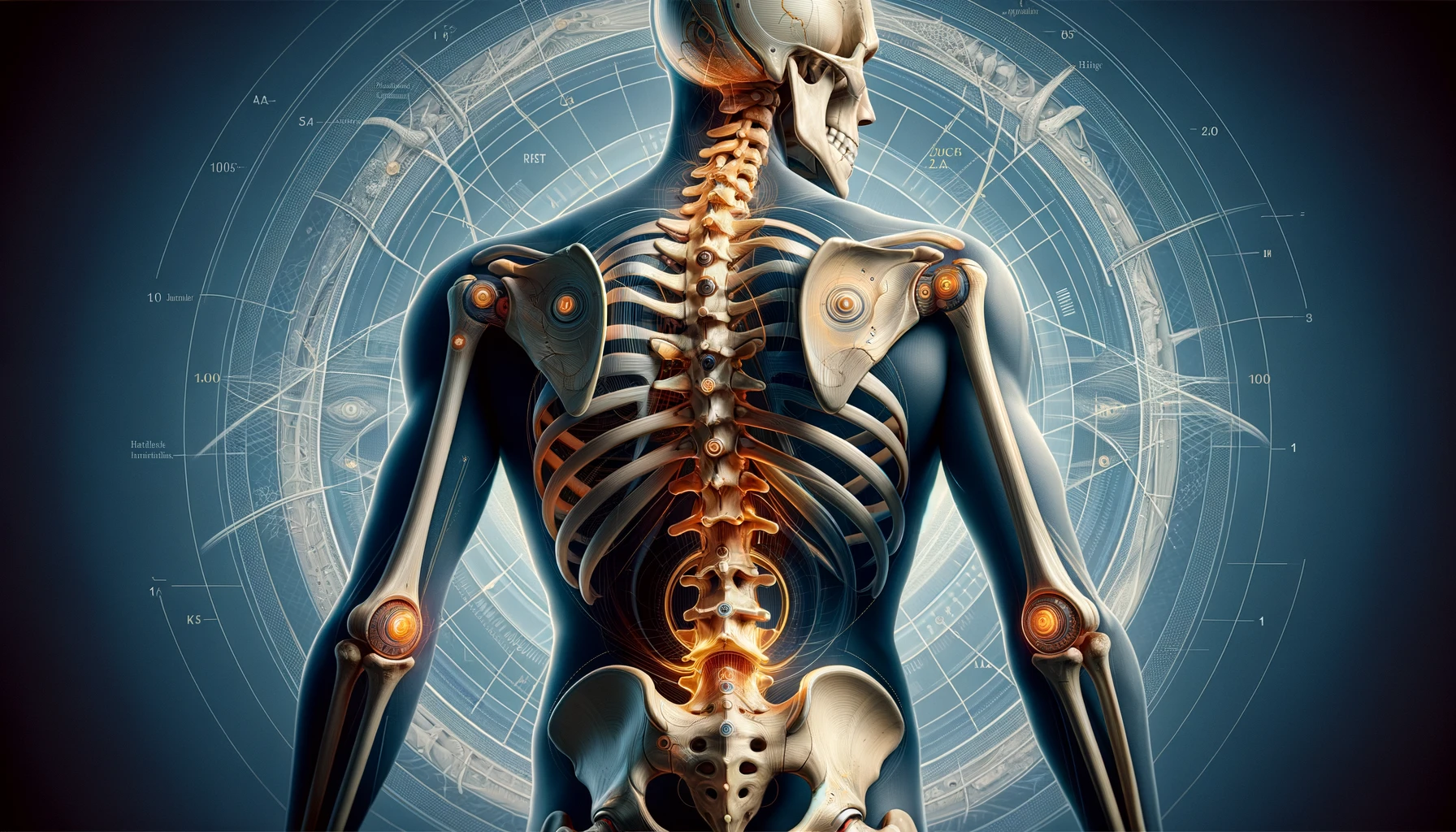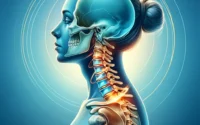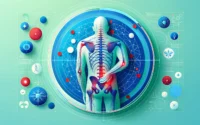Understanding the L5-S1 (Lumbosacral) Joint
Last Updated on February 8, 2024 by Lily

Key Takeaways
1. The L5-S1 joint, located in the lower back, plays a crucial role in supporting body weight and facilitating movement.
2. Issues like disc herniation or degeneration at this joint can lead to symptoms like lower back pain, leg pain, and numbness.
3. Treatment options range from conservative measures like physical therapy to more invasive interventions like surgery, depending on the severity of the condition.
4. Maintaining a healthy lifestyle, including regular exercise, proper posture, and weight management, can help prevent or alleviate L5-S1 joint issues.
The L5-S1 joint, located at the base of the spine where the lumbar vertebra L5 meets the sacrum S1, plays a crucial role in providing stability, support, and flexibility to the lower back. This article delves into the intricate anatomy, essential functions, and prevalent disorders affecting the L5-S1 joint, offering insights into its significance for spinal health.
Anatomy of the L5-S1 Joint
The L5-S1 joint comprises the fifth lumbar vertebra (L5) and the first sacral vertebra (S1), interconnected by the intervertebral disc and supported by ligaments and surrounding musculature. L5 is the largest and strongest lumbar vertebra, while S1 marks the transition to the sacrum, forming the foundation of the spine’s lower portion.
The lumbar spine consists of five vertebrae, labeled L1 through L5, with L5 situated closest to the sacrum. The sacrum, a triangular-shaped bone formed by the fusion of five sacral vertebrae, connects the spine to the pelvis. The L5-S1 joint represents the interface between the lumbar spine and the sacrum, bearing the majority of the body’s weight and facilitating various movements essential for daily activities.
Function of the L5-S1 Joint
The L5-S1 joint facilitates various movements of the lower back, including flexion, extension, lateral bending, and rotation. It bears the majority of the body’s weight and absorbs forces during activities such as walking, lifting, and bending. The intervertebral disc acts as a shock absorber, while ligaments provide stability to prevent excessive motion.
During flexion, the L5-S1 joint allows forward bending of the spine, while extension involves backward bending. Lateral bending refers to sideways movement, and rotation involves twisting of the spine around its axis. These movements occur in coordination with adjacent vertebral levels, contributing to overall spinal mobility and function.
Common Disorders Affecting the L5-S1 Joint
- Degenerative Disc Disease (DDD) Degenerative changes in the intervertebral disc, characterized by loss of disc height, dehydration, and altered biomechanics, contribute to DDD. Symptoms include chronic lower back pain, stiffness, and decreased range of motion. Treatment options range from conservative measures like physical therapy and medications to surgical interventions such as discectomy or spinal fusion.
- Herniated Disc (Disc Herniation) A herniated disc occurs when the inner gel-like nucleus protrudes through a tear or weakened area in the outer annulus fibrosus. This can lead to compression of nearby nerves, resulting in radicular pain, numbness, tingling, or weakness in the buttocks, legs, or feet. Treatment may include rest, pain management, epidural steroid injections, or surgery in severe cases.
- Spondylolisthesis Spondylolisthesis involves the forward displacement of one vertebra over the adjacent one, commonly occurring at the L5-S1 level. Causes include congenital anomalies, degenerative changes, or traumatic injury. Symptoms range from lower back pain to neurological deficits, depending on the degree of slippage. Treatment options encompass conservative approaches like bracing, physical therapy, or surgical stabilization.
- Lumbar Spinal Stenosis Lumbar spinal stenosis refers to the narrowing of the spinal canal or neural foramina, resulting in compression of the spinal cord or nerve roots. Symptoms typically include pain, numbness, or weakness in the lower back, buttocks, or legs, exacerbated by standing or walking. Treatment options vary from conservative measures like activity modification and analgesics to surgical decompression procedures.
Prevention and Management Strategies
Maintaining a healthy weight, practicing good posture, engaging in regular exercise, and avoiding smoking are essential for preserving the integrity of the L5-S1 joint and minimizing the risk of associated disorders. Incorporating core-strengthening exercises, flexibility training, and ergonomic principles into daily activities can further promote spinal health and reduce the likelihood of injury.
Seeking Medical Care
Persistent or worsening back pain, radiating symptoms, or neurological deficits warrant prompt evaluation by a healthcare professional. A thorough history, physical examination, and diagnostic imaging studies like X-rays, MRI, or CT scans may be utilized to assess the underlying cause of symptoms. Treatment recommendations are tailored to the individual’s specific condition, considering factors such as severity, functional impairment, and treatment goals.
The L5-S1 joint serves as a vital component of the lumbar spine, contributing to stability, mobility, and weight-bearing functions. Understanding its anatomy, function, and common disorders is paramount for promoting spinal health and addressing associated issues effectively. By adopting preventive measures, seeking timely medical care, and adhering to appropriate treatment strategies, individuals can optimize the health and function of the L5-S1 joint, fostering overall well-being and quality of life.
Diagnostic Evaluation of L5-S1 Disorders
Diagnostic evaluation of L5-S1 disorders typically begins with a comprehensive medical history and physical examination. The healthcare provider assesses the patient’s symptoms, medical history, occupational factors, and lifestyle habits to identify potential contributing factors.
Imaging studies such as X-rays, MRI (Magnetic Resonance Imaging), or CT (Computed Tomography) scans may be ordered to visualize the structures of the lumbar spine, including the L5-S1 joint, intervertebral discs, vertebrae, and surrounding soft tissues. These imaging modalities provide detailed information about the presence of degenerative changes, disc herniation, spondylolisthesis, or spinal stenosis.
In certain cases, diagnostic procedures like electromyography (EMG) or nerve conduction studies (NCS) may be performed to assess nerve function and identify any abnormalities or signs of nerve compression. These tests help differentiate between radicular pain originating from nerve root impingement and other musculoskeletal conditions affecting the lower back.
Conservative Treatment Options for L5-S1 Disorders
Conservative treatment options for L5-S1 disorders aim to alleviate symptoms, improve function, and prevent disease progression. These approaches often form the initial line of management before considering more invasive interventions.
- Medications: Nonsteroidal anti-inflammatory drugs (NSAIDs), muscle relaxants, analgesics, and neuropathic pain medications may be prescribed to alleviate pain, inflammation, and muscle spasms associated with L5-S1 disorders.
- Physical Therapy: Physical therapy focuses on strengthening the core muscles, improving flexibility, correcting posture, and enhancing body mechanics. Therapeutic exercises, manual techniques, modalities (e.g., heat, ice), and education on proper ergonomics are integral components of physical therapy programs.
- Chiropractic Care: Chiropractic adjustments, spinal manipulation, mobilization techniques, and adjunctive therapies (e.g., ultrasound, electrical stimulation) may be utilized to restore spinal alignment, alleviate joint dysfunction, and reduce nerve irritation in patients with L5-S1 disorders.
- Interventional Procedures: Epidural steroid injections, facet joint injections, sacroiliac joint injections, or nerve blocks may be considered for patients with persistent or severe pain refractory to conservative measures. These procedures deliver medications directly into the affected area to reduce inflammation, alleviate pain, and improve function.
Surgical Treatment Options for L5-S1 Disorders
Surgical treatment options for L5-S1 disorders are reserved for cases where conservative measures fail to provide adequate symptom relief or when there is evidence of progressive neurological deficits or structural instability requiring intervention. The choice of surgical procedure depends on the underlying pathology, patient’s clinical presentation, and surgeon’s expertise.
- Discectomy: Discectomy involves the removal of herniated disc material compressing the spinal nerves or spinal cord. This procedure aims to decompress the affected nerve roots, alleviate radicular symptoms, and restore neurological function.
- Laminectomy: Laminectomy, also known as decompressive laminectomy, entails the removal of the lamina (bony arch) of the affected vertebra to create more space within the spinal canal. This relieves pressure on the spinal cord or nerve roots caused by spinal stenosis, thereby alleviating symptoms of pain, numbness, or weakness.
- Spinal Fusion: Spinal fusion involves the surgical fusion of adjacent vertebrae to stabilize the L5-S1 joint and promote bony union. This procedure is indicated for conditions like spondylolisthesis, degenerative disc disease, or spinal instability unresponsive to conservative measures. Instrumentation such as screws, rods, or cages may be utilized to enhance fusion and provide additional structural support.
Rehabilitation and Recovery
Rehabilitation and recovery following surgical intervention for L5-S1 disorders are integral components of the treatment process. Physical therapy, occupational therapy, and home exercise programs are essential for promoting healing, restoring function, and optimizing outcomes.
- Early Mobilization: Early mobilization and ambulation are encouraged to prevent complications such as muscle weakness, joint stiffness, and venous thromboembolism. Patients are instructed to engage in gentle activities of daily living and gradually progress to more strenuous exercises under the guidance of rehabilitation professionals.
- Physical Therapy: Physical therapy focuses on strengthening the core muscles, improving spinal stability, enhancing flexibility, and addressing gait abnormalities. Therapeutic exercises, manual techniques, aquatic therapy, and modalities like ultrasound or electrical stimulation may be incorporated into the rehabilitation program.
- Pain Management: Pain management strategies may include pharmacological interventions, such as analgesics or muscle relaxants, as well as nonpharmacological approaches like ice or heat therapy, transcutaneous electrical nerve stimulation (TENS), or acupuncture. These modalities help alleviate postoperative pain, reduce inflammation, and promote tissue healing.
- Education and Support: Patient education plays a crucial role in promoting adherence to postoperative precautions, optimizing functional outcomes, and preventing recurrence of symptoms. Patients are provided with information about proper body mechanics, ergonomics, activity modification, and strategies for preventing future spine-related injuries.
Long-Term Management and Follow-Up
Long-term management and follow-up are essential for monitoring the patient’s progress, addressing any residual symptoms or complications, and promoting overall spinal health. Regular follow-up visits with the healthcare provider, rehabilitation specialist, or spine surgeon are scheduled to assess functional outcomes, monitor radiographic findings, and adjust the treatment plan as needed.
- Lifestyle Modifications: Lifestyle modifications such as maintaining a healthy weight, adopting ergonomic workstations, practicing proper body mechanics, and engaging in regular exercise are encouraged to prevent recurrence of L5-S1 disorders and promote long-term spinal health.
- Preventive Measures: Preventive measures such as fall prevention strategies, proper lifting techniques, and spine-protective exercises are emphasized to reduce the risk of reinjury or exacerbation of preexisting spinal conditions.
- Health Promotion: Health promotion activities such as smoking cessation, stress management, and adherence to a balanced diet rich in essential nutrients are advocated to optimize overall health and well-being.
Conclusion
In conclusion, the comprehensive management of L5-S1 disorders requires a multidisciplinary approach involving medical, surgical, rehabilitative, and preventive strategies. By understanding the anatomy, function, and common disorders affecting the L5-S1 joint, healthcare providers can deliver individualized care aimed at maximizing functional outcomes, improving quality of life, and promoting long-term spinal health. Through collaboration, education, and empowerment, patients can navigate the journey of recovery with confidence and resilience, achieving optimal outcomes and reclaiming their active lifestyles.



